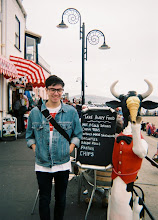
I then began to work with double-exposures. At first I photographed two completely different flowers and overlapped them, I felt that this could link to the idea of fiction and truth in photography and the project. When we see a polaroid image we automatically assume that what is being photographed is the truth, in that the camera can only photograph what is physically there, and as it is created there and then what we are seeing must be "true". The polaroid photograph is intrinsically linked to the idea of the veracity of the image and the chemical process. This links to Bazin-ian film theories of realism and truth. The double-exposure questions the veracity of the image, often the images are quite subtley double-exposures which at first glance do not appear so unusual. The below images are examples of this.



After these images I started to think about the Cubist attitudes towards multiple angles in their paintings, most famously Picasso's work (below), which often incorporates several different views of the subject as he would move around painting it. I photographed the same lavender plant from three different angles which created multiple-exposed image similar in concept if not style, to cubist works. (left)


No comments:
Post a Comment